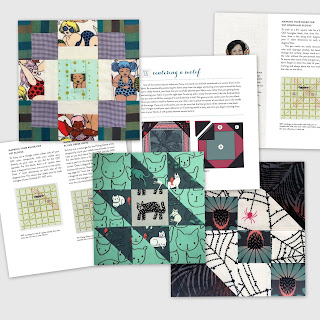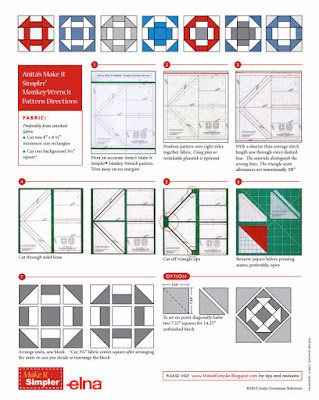My Portable Design Wall is Simply a Batting Pillowcase
December 2018
Once upon a time, more than anything I wanted a rigid portable design wall. There isn’t enough wall space in my Manhattan apartment for a 'built-in' design wall.
I tried to find insulation boards here on this island of 1.65 million people to make a design wall. There weren't any to be bought. Besides, how would I get the board home? On a bus? The subway? I don’t have a car. At 96” x 48”, what sort of vehicle could accommodate it?
 |
| I had resorted to using a metal door and magnets to hold blocks on the front door. |
Finally the truck arrived. The doorman called me on the intercom to announce two men were on the way up. I waited, and waited, and waited. Where had they gone? I buzzed down to the doorman. “Mrs. Solomon,” he said, “the boards are 96 inches tall. They won’t fit in the elevator. The men are on their way, walking up the stairs.” Gulp.
I made my first portable design wall with batting and white duct tape. It was sort of like Scotch taping a hem in place. Awkward and inelegant. I wondered if I could encasing a board in a ‘pillowcase’ made of batting instead of using tape or pins. The answer was YES. If you want to get an idea of what the boards look like in real life, click here.
The 96” x 48” board was taller than I needed so I cut 12” off of an end, to make it 84” x 48:
For the 'pillowcase' I chose cotton batting because quilt blocks will “stick” to cotton. To keep the pillowcase from stretching over time, I chose cotton batting with a polypropylene scrim. I would expect a blend — say 80 percent cotton and 20 percent polyester — to work just fine as well.
I chose Queen Size (90” x 108”) batting to make the pillowcase. Here’s my reasoning and math:
- I needed at least 84” top-to-bottom + wiggle room, so 90” would be sufficient
- The board is 48” across the front and 48” across the back; 96” in all. I figured 108” would be sufficient to cover the combined 96” and to generously allow 2” for the left edge and 2” for the right edge. 96 + (2 + 2) = 100
Step 1
Step 2
Step 3:
Sew along the top and side of the pillowcase, but not along the bottom and not along the folded side. I sewed with a 1¼” seam allowance. That’s 1¼” away from the marked line, toward the edge of the batting. Trim away excess batting from the top and the side, leaving about an inch in case you need to make an alteration. Turn the pillowcase inside-out to conceal the seams.
Along the top edge, the seam allowance isn’t critical. The pillowcase will be too long as it is.
Consider sewing the side with a very long stitch; a basting stitch is easier to rip out if necessary. Then try out the pillowcase. If it’s a go, reinforce the basting if you wish.
In this sewing video, I demonstrate how I use the Elna AcuFeed foot which acts as a walking foot, a size #14 quilting needle and a long stitch.
Placing the pillowcase over your board:
To load the pillowcase, I stood facing a free-standing sofa and held the board upright in front of me. I tilted the board and let it fall back onto the sofa. The sofa supported the far end of the board while the pillowcase was slipped over the near end.
After a few inches are loaded, it should slide on. Be patient. If it doesn’t slide on, then resew and increase the seam allowance. Then remove the side stitches that served as “pins.”
If the pillowcase isn’t as taut as you’d like, resew or clamp with large metal binding clips.
Finishing your portable design wall:
It will take two people to maneuver
the pillowcase over the board. To finish, either cut off the excess at the
bottom (you have the previously marked line for a guide) or tuck excess up into
an inside-out hem.- I unstitched the side seam near the bottom
- Then, I serged off the bottom edge, an ‘open’ single layer
- From there, I serged along the top
- Finally, I serged the side from top-to-bottom. It turned out so pretty.


























































